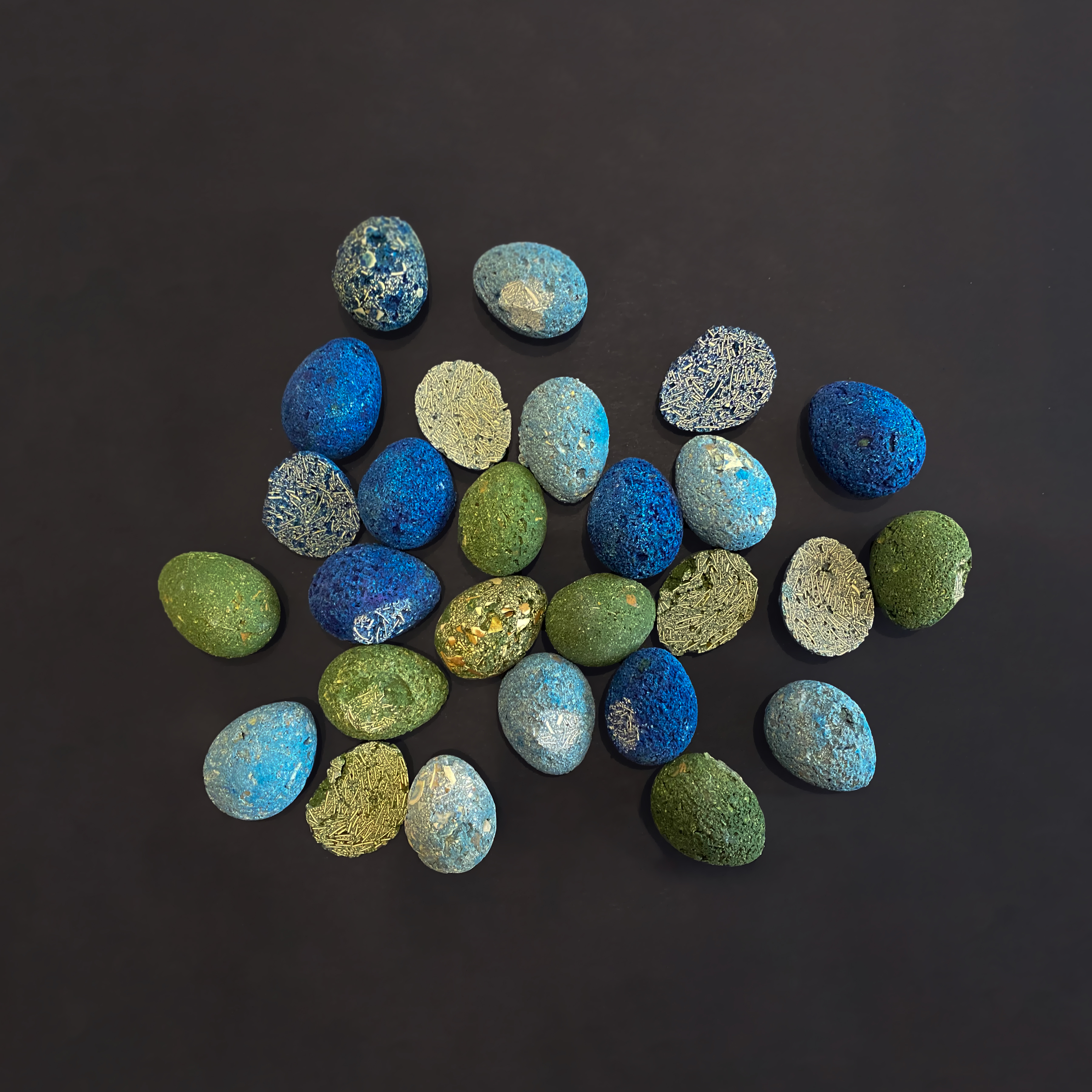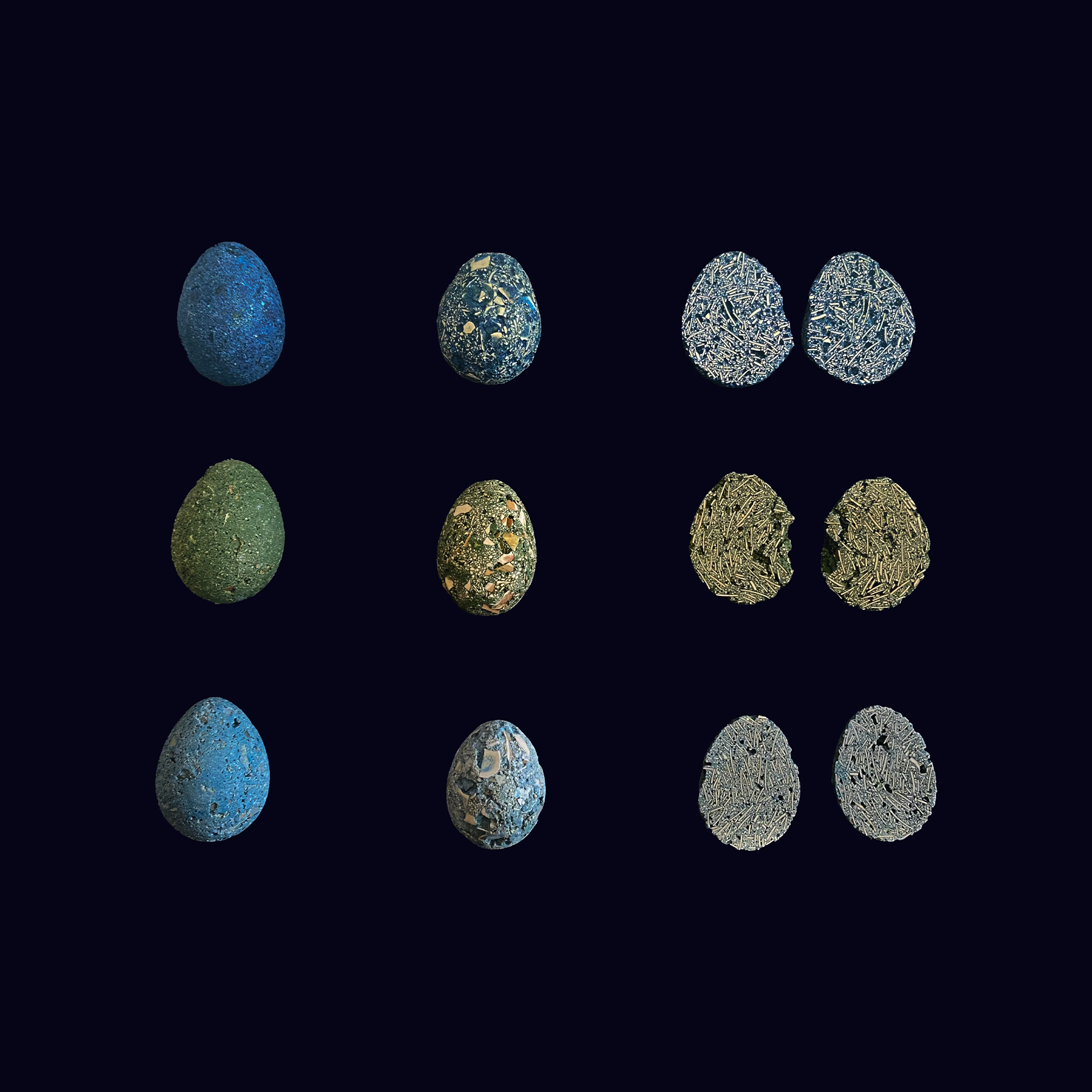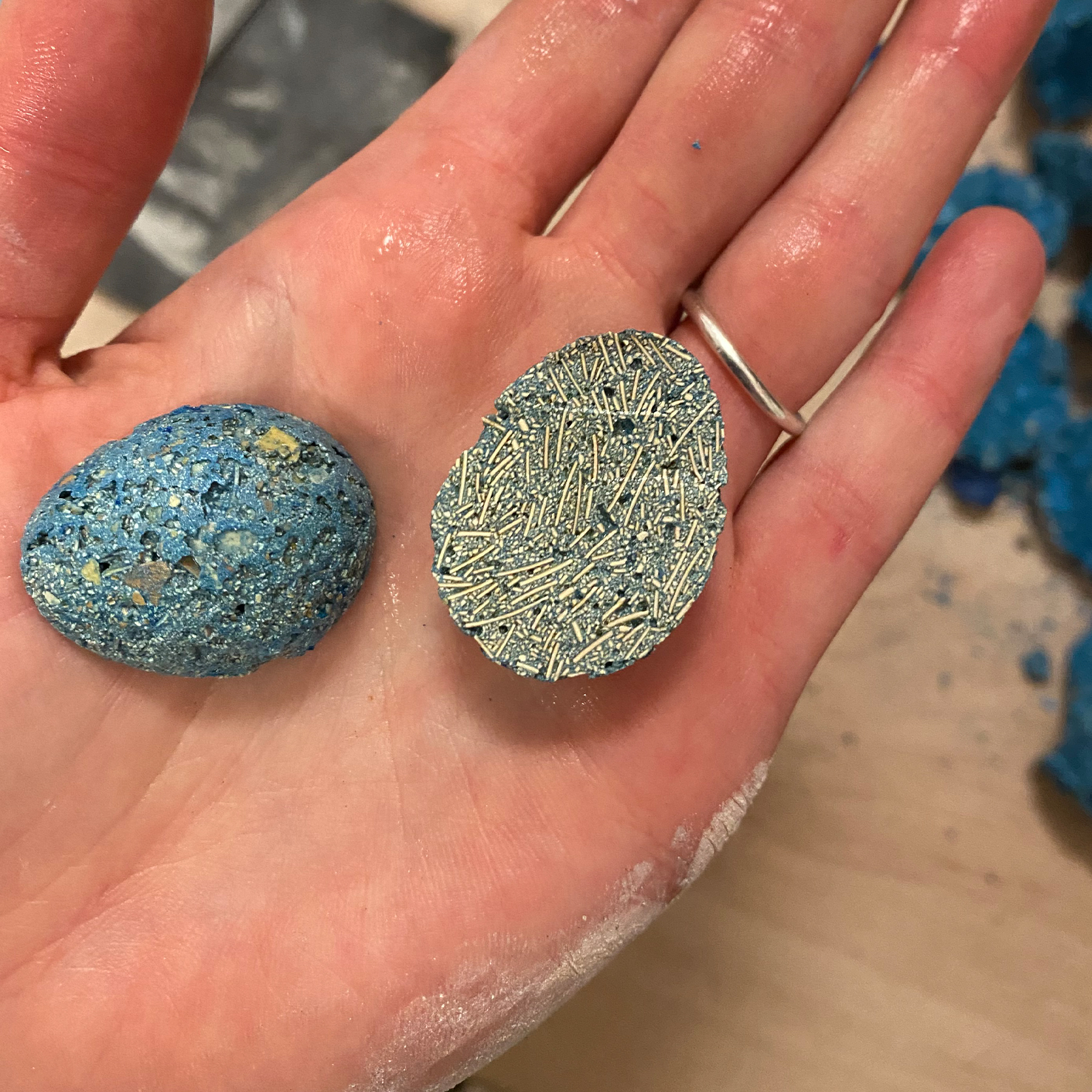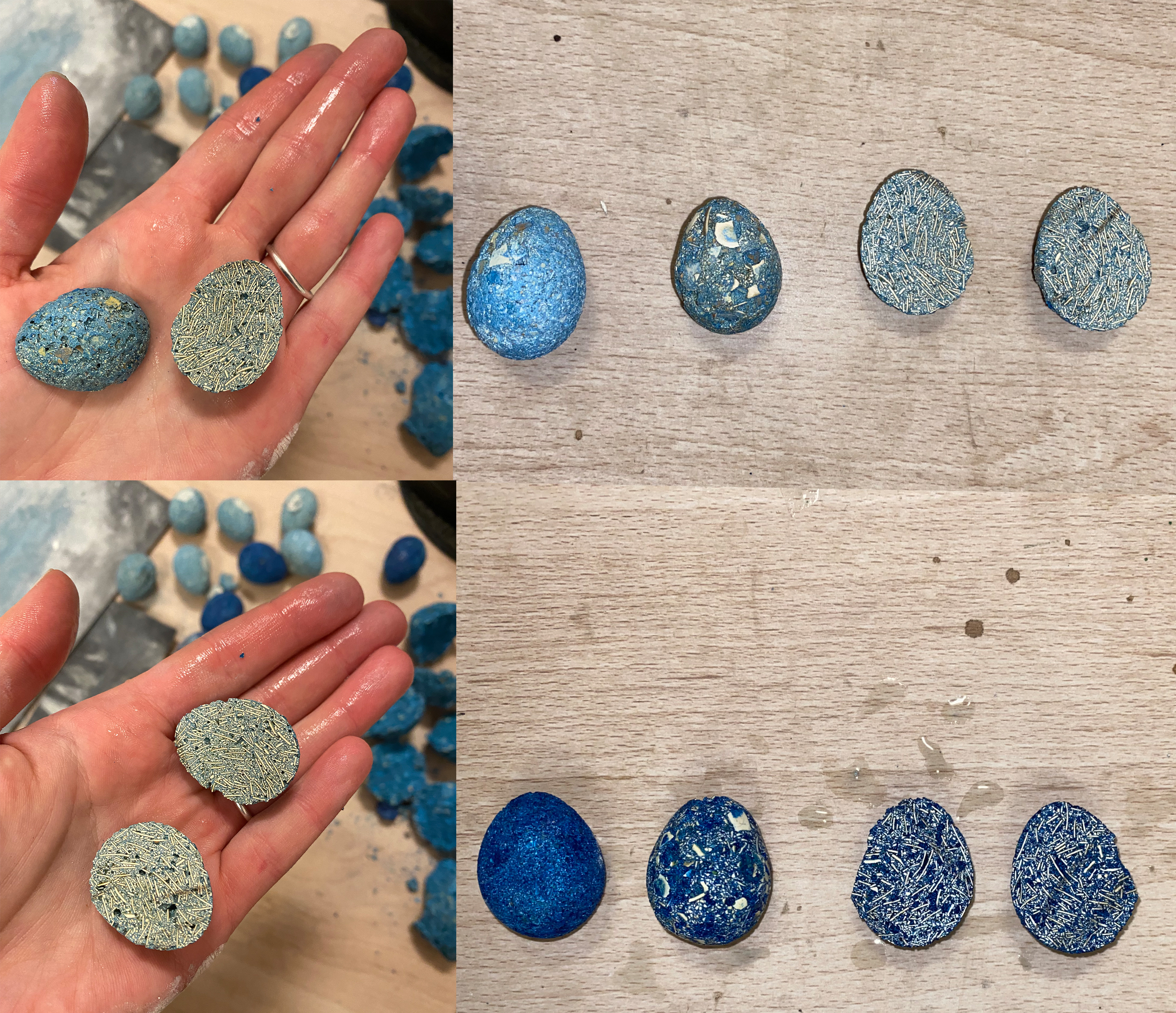Shaping a circular industrial ecosystem and supporting life-cycle thinking
Development of a product Reloaded stones
Development of artificial stones „Reloaded stones“ using waste materials unsuitable for recycling
The project analyzes the relation of carbonate-class minerals calcite, aragonite, dolomite and hen eggshells. The chemical composition of these stones almost perfectly coincides with eggshells found in almost every person's household environment. By reloading crushed, disintegrated materials, re-mixing them and connecting them together a new environmentally friendly and aesthetically pleasant stone is created, which promotes zero-waste policy and is an alternative material for precious stones.
Lithuania
National
Mainly urban
It refers to a physical transformation of the built environment (hard investment)
Prototype level
No
No
As an individual
The main goal of the project is to conserve natural resources by processing the relevant food waste into artificial, sustainable "stones", which could be used for the production of jewelry and other design products. In the course of this study, the technology for the production of "stones", which was discovered in the previous initial stages of research, will be tried to be applied to other selected waste unsuitable for industrial recycling. By improving the technology and opening up a wider list of usable wastes, the material being developed will broadcast sustainability policy and offer an aesthetically attractive, safe-to-use product, as well as demonstrate wide possibilities for application and use.
At the current stage of the project, the technology and recipe for the production of artificial "stones" from chicken eggshells and liquid glass are developed, the first prototypes are made. Also, the prospect of applying this technology to other wastes dominated by calcium carbonade has been discovered, for example seafood shells and etc.
The project concerns producers of such waste as larger companies and small consumers, proposing a plan for the recycling and recovery of such waste. For example, in this case, in cooperation with local bakeries, eggshells collected from them are processed into new material used in the design, etc. This project promotes zero-waste policy, responds to the principles of the circular economy and develops a new, sustainable aesthetically attractive material from waste that could replace more expensive materials in design and jewelry, and maybe even in the construction industry. It also creates an opportunity for businesses and residents to contribute to this type of waste management on both large and small scales.
At the current stage of the project, the technology and recipe for the production of artificial "stones" from chicken eggshells and liquid glass are developed, the first prototypes are made. Also, the prospect of applying this technology to other wastes dominated by calcium carbonade has been discovered, for example seafood shells and etc.
The project concerns producers of such waste as larger companies and small consumers, proposing a plan for the recycling and recovery of such waste. For example, in this case, in cooperation with local bakeries, eggshells collected from them are processed into new material used in the design, etc. This project promotes zero-waste policy, responds to the principles of the circular economy and develops a new, sustainable aesthetically attractive material from waste that could replace more expensive materials in design and jewelry, and maybe even in the construction industry. It also creates an opportunity for businesses and residents to contribute to this type of waste management on both large and small scales.
Recycling
Waste
New material
Design
Chicken eggshell
The main objectives of the project related to sustainability are to conserve natural resources, promote the principles of the circular economy, discover alternative recycling methods, reduce pollution, seek for the most sustainable production, use local resources and create a sustainable product.
Using certain wastes to create a new product is one of the ways to achieve these goals. In this case, for the creation of synthetic stones for design and jewelry, chicken eggshells are used, which form the main component of the entire product. The choice of such a material is suitable due to the fact that a large amount of eggs are produced every year in the world, but in most cases the shell of the egg is simply thrown away. It is estimated that this results in around 7.2 million tonnes of eggshell waste each year, which are usually transported directly to landfills, where they pollute the environment and the land. However, in the project it becomes a secondary raw material and a useful economic resource. This method of using shells is new, so the project is also looking for alternative recycling methods that would reduce the pollution of such garbage.
The project aims to create the most sustainable product possible, and with it its technology with the production process. Therefore, first of all, local resources are used – eggshells, which are widely used in various food productions, as well as in the kitchens of hotels, cafes and residents. The binding material chosen for production – liquid glass is widely used in various fields. Liquid glass can provide many useful properties when creating a quality product, such as water and fire resistance, withstanding heavy loads, gluing properties, drying and hardening in air, protection from bacteria. This also refers to a production process that does not require a lot of energy and other resources.
Using certain wastes to create a new product is one of the ways to achieve these goals. In this case, for the creation of synthetic stones for design and jewelry, chicken eggshells are used, which form the main component of the entire product. The choice of such a material is suitable due to the fact that a large amount of eggs are produced every year in the world, but in most cases the shell of the egg is simply thrown away. It is estimated that this results in around 7.2 million tonnes of eggshell waste each year, which are usually transported directly to landfills, where they pollute the environment and the land. However, in the project it becomes a secondary raw material and a useful economic resource. This method of using shells is new, so the project is also looking for alternative recycling methods that would reduce the pollution of such garbage.
The project aims to create the most sustainable product possible, and with it its technology with the production process. Therefore, first of all, local resources are used – eggshells, which are widely used in various food productions, as well as in the kitchens of hotels, cafes and residents. The binding material chosen for production – liquid glass is widely used in various fields. Liquid glass can provide many useful properties when creating a quality product, such as water and fire resistance, withstanding heavy loads, gluing properties, drying and hardening in air, protection from bacteria. This also refers to a production process that does not require a lot of energy and other resources.
The main objectives of the project related to aesthetics and quality of experience for people, are to promote the ideas of sustainability in the arts and design sectors, to adapt the old crafts in today's problematic context of waste management, to create a high-quality and aesthetically attractive product that would be applicable in design and jewelry.
In the modern context, it is important to respond to the problem of waste management and promote the ideas of sustainability not only in everyday life, but also in art, design, culture. Such creative solutions, which speak and use appropriate materials, can educate and encourage society to live a cleaner life. In this case, „Reloaded stones“ is made from minerals extracted from the recycled eggshells, a waste product of the food industry. Their chemical composition corresponds to the carbonate class of rocks found in the natural environment. The project analyses the chemical and aesthetic relationship between the minerals calcite, aragonite, dolomite and chicken eggshells. The main element of the product, the eggshell, conveys an ecological circular transformation: earth – bird – man – earth. It brings attention to consumerism, the footprint left by human rubbish in nature, finite resources and the idea of zero waste. The variety and choice of jewellery available on the market is great, but only a small number of pieces are unique and exclusive in form and materials. More and more people are interested in original works and are looking for more original contemporary design solutions. The project’s product development is attractive in its idea of creating jewellery and design by conserving natural resources and recycling relevant food waste. The product that is created replicates a moment in nature’s cycle: the same minerals circulate from the stone to the shell, and the shell back to the stone – the stone is reprogrammed for new usage.
In the modern context, it is important to respond to the problem of waste management and promote the ideas of sustainability not only in everyday life, but also in art, design, culture. Such creative solutions, which speak and use appropriate materials, can educate and encourage society to live a cleaner life. In this case, „Reloaded stones“ is made from minerals extracted from the recycled eggshells, a waste product of the food industry. Their chemical composition corresponds to the carbonate class of rocks found in the natural environment. The project analyses the chemical and aesthetic relationship between the minerals calcite, aragonite, dolomite and chicken eggshells. The main element of the product, the eggshell, conveys an ecological circular transformation: earth – bird – man – earth. It brings attention to consumerism, the footprint left by human rubbish in nature, finite resources and the idea of zero waste. The variety and choice of jewellery available on the market is great, but only a small number of pieces are unique and exclusive in form and materials. More and more people are interested in original works and are looking for more original contemporary design solutions. The project’s product development is attractive in its idea of creating jewellery and design by conserving natural resources and recycling relevant food waste. The product that is created replicates a moment in nature’s cycle: the same minerals circulate from the stone to the shell, and the shell back to the stone – the stone is reprogrammed for new usage.
The main objectives of the project related to inclusion are to create new jobs involving artistic practices, crafts and design, to create a cheaper, more accessible alternative material for expensive materials of this type, to create a waste management system in which this type of waste is collected and recycled.
The application of old and already existing technologies and crafts in working with waste can create new job places. It's also a great way to remind the public about the old crafts and let them shine in today's current affairs and maybe even encourage the choice of such a professional direction. Also, such material would be a cheaper and more affordable alternative to natural decorative stones in design and jewelry. It would also contribute to the preservation of dwindling finite natural resources. Artificial stones made from eggshells could replace carbonate-class stones (calcite, dolomite and aragonite) with their similar chemical composition, which are widely used in construction, design and jewelry. It could also replace many decorative stones with their physical properties and appearance, since this material is characterized by strength, ease of processing, resistance, and in the meantime, a beautiful pattern and a pleasant texture. Also, because eggshell waste is an endless, cheap raw material, and the technology of stone production itself does not require a lot of resources and energy, such artificial stones would be relatively inexpensive and accessible to everyone. In addition, the use of eggshells in the design sphere could lead to cooperation between companies producing such waste, such as, for example, hotels, cafes or other businesses and designers and artists. This project proposes not only a plan on how to responsibly deal with such waste, but also how to turn it into a profitable and useful resource and raw material.
The application of old and already existing technologies and crafts in working with waste can create new job places. It's also a great way to remind the public about the old crafts and let them shine in today's current affairs and maybe even encourage the choice of such a professional direction. Also, such material would be a cheaper and more affordable alternative to natural decorative stones in design and jewelry. It would also contribute to the preservation of dwindling finite natural resources. Artificial stones made from eggshells could replace carbonate-class stones (calcite, dolomite and aragonite) with their similar chemical composition, which are widely used in construction, design and jewelry. It could also replace many decorative stones with their physical properties and appearance, since this material is characterized by strength, ease of processing, resistance, and in the meantime, a beautiful pattern and a pleasant texture. Also, because eggshell waste is an endless, cheap raw material, and the technology of stone production itself does not require a lot of resources and energy, such artificial stones would be relatively inexpensive and accessible to everyone. In addition, the use of eggshells in the design sphere could lead to cooperation between companies producing such waste, such as, for example, hotels, cafes or other businesses and designers and artists. This project proposes not only a plan on how to responsibly deal with such waste, but also how to turn it into a profitable and useful resource and raw material.
People and local enterprises got involved in the project by collecting eggshells, thereby contributing to the creation of the material by providing free raw materials for the product and sorting and responsibly getting rid of such waste.
Vilnius Academy of Arts noticed the project and it was proposed to be included in InoAcademy program, designed to help young students develop their business. Also, the project abstained support and became interested at the national and international levels. It was nominated at the Lithuanian Young Design Awards, was exhibited at the London Design Festival in 2021, in international exhibition at Sieraad in Amsterdam in 2022, at Dutch Design Week in Eindhoven as part of the InoAcademy project in 2022. As a result, more people could see the project. Also, this prompted the continuation of the project and led to the improvement of the material in order to apply it more widely.
In this project, the fields of design, jewelry, art and chemical science are intertwined. As a creator myself, I have knowledge and background in metal art, jewelry and bio-materials, so in consultation with specialists of chemistry, I managed to understand and solve chemical problems of the substance.
There are no eggshell-based products in Lithuania. Partially, jewelry made of cement can be attributed to the primary competitors in Lithuania. Jewelry maker Gerda Liudvinavičiūtė creates jewelry "Celsius 273" from a building material – cement. Another creator Agnė Žaltauskaitė creates unique handmade jewelry made of recycled paper, recycled plastic and silver. Analyzing the competitive environment in Europe, several developers in Germany were found who use similar production techniques and materials. The “Shell Homage” biomaterial project is similar to this project because it creates a material that is applicable in design and jewelry from eggshells and resin. Another primary competitor in the European market is the collection of artistic jewelry "Oval" (Joohee Han, Germany). For objects of the collection, eggshell and technical silicone are used as the main material. Meanwhile, the current, improved "Reloaded Stones" are made from eggshells and liquid glass. This is a much more sustainable and cheaper project, due to the fact that it does not contain either resin or silicone in its composition, which are also significantly more expensive binding materials. Also, their presence in the composition of the products makes it difficult to mechanically process the material and further processing and recycling of the product. For these reasons, "Reloaded stones" outperforms its main competitors.
All in all, the strengths of the project are: The uniqueness and sustainability of the material, the product responds to the needs of innovative jewelry and design, the product is sustainable with its quality, idea and production technique, attractive quality and price ratio, agile modeling and reproduction, simple technology, aesthetic material.
All in all, the strengths of the project are: The uniqueness and sustainability of the material, the product responds to the needs of innovative jewelry and design, the product is sustainable with its quality, idea and production technique, attractive quality and price ratio, agile modeling and reproduction, simple technology, aesthetic material.
The project used the qualitative mythology of the work. First of all, the already existing material necessary for the study was collected and analyzed. Then, with the help of the knowledge gained from my previous similar research and the collected literature, experiments were conducted to create the material. The results obtained are analyzed and described, the technology is improved, prototypes are produced and tested.
The application and use of the material in various fields, the production and processing of materials and products from it, the collection of the necessary resources for it and the learning of technology are elements of the project that could be replicated in other places.
The resources needed for the product – the collection of chicken eggs could be carried out anywhere where there is this type of waste, as it is a food waste that is almost all over the world. Since the components of the product liquid glass and eggshell are relatively inexpensive and easily accessible materials in many parts of the world, this would allow the production of the project product to be replicated and even further developed in those places. Also, since the product technology is not complicated and it is possible to do without expensive machines for its processes, this would thus contribute to the possibilities of replicating the product elsewhere. The versatility of the material itself and its ease of processing would allow it to be applied in various fields and products - from design to construction, and so on. Also, the technology can be applied to the management of other waste of this type, such as seafood shells.
The resources needed for the product – the collection of chicken eggs could be carried out anywhere where there is this type of waste, as it is a food waste that is almost all over the world. Since the components of the product liquid glass and eggshell are relatively inexpensive and easily accessible materials in many parts of the world, this would allow the production of the project product to be replicated and even further developed in those places. Also, since the product technology is not complicated and it is possible to do without expensive machines for its processes, this would thus contribute to the possibilities of replicating the product elsewhere. The versatility of the material itself and its ease of processing would allow it to be applied in various fields and products - from design to construction, and so on. Also, the technology can be applied to the management of other waste of this type, such as seafood shells.
Climate change and poverty are global challenges that are addressed in the project. Collecting and responsible recycling of waste contributes to the reduction of climate change, and the creation of a product that is a cheaper alternative to expensive materials contributes to the reduction of poverty. This project collects food waste – chicken eggshells, which are usually transported directly to landfills, where they pollute the environment and the earth with microbes and their extremely pungent smell of ammonia, hydrogen sulfide and amines. Since, according to the Regulation of the European Union, the eggshell is considered a hazardous waste, and it has many properties suitable for the project, such as thermal stability, chemical resistance and adsorption, it becomes an excellent mineral raw material for the formation of artificial stones, suitable both in composition and in terms of the principles of the circular economy. Also, the material based on eggshells, which is being developed, becomes a cheap alternative in the field of design, construction and products of other areas, which can replace expensive ones. By offering a cheaper option to people on the verge of poverty, it could help them.
It is planned to further develop the new product "Reloaded Stones" in 2025, developing the design and technology of artificial "stones", using waste materials unsuitable for recycling. First of all, it is planned to make a detailed laboratory study of the selected prototypes already produced. There is a desire to study in detail the chemical and physical properties of the prototypes. After receiving the results of laboratory tests, it is planned to conduct an analysis of these studies. Depending on the results of research, it is planned to carry out correction and improvement of the material. Next, it is planned to create the concept, sketches and exposition works of the exhibition collection. After that, it is planned to prepare advertising materials for exhibitions, that is, the preparation of visual material - taking photos and videos, as well as the preparation of informative material - relevant texts and articles, as well as other preparatory works. It is planned to participate with work in the Netherlands, Eindhoven, the exhibition "Dutch Design Week 2025" and other local Lithuanian exhibitions. Expected main results by 2027: - 2 Articles - 3 or 4 International Exhibitions - 1 trial of a new product in production - 1 new technology - 1 prototype collection - 1 application of technology to other waste.




